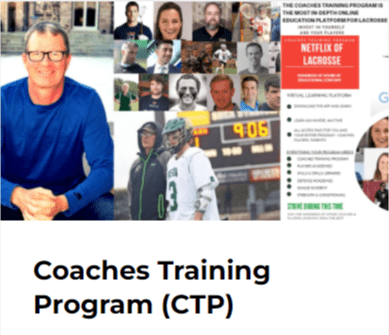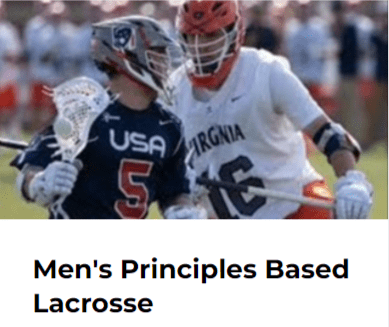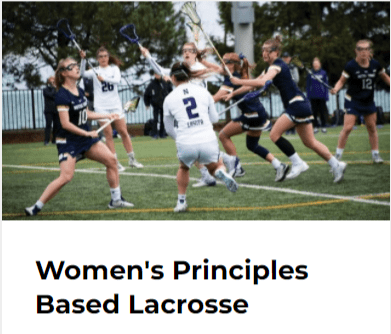A Lacrosse Weekend 3.26.22
Welcome to "A Lacrosse Weekend" my weekly compilation of thoughts, ideas, stories, myths, truths, about the great game of lacrosse. I hope you enjoy it!
If you are a men's or women's lacrosse player, coach, or parent, I think you will love the weekly content, videos, and analysis.


JM3 And Mass Bay Youth Lacrosse Team up!
I am excited to announce that JM3 Sports is working on a pilot program of coach education for seven MBYLL boys and girls towns this spring. JM3 has created online courses and content detailing cutting edge coaching philosophy, videos of drills and games, as well as practice plans, which will be supplemented each week in office hour Zoom calls where the focus will be on helping coaches optimize practice environments through watching film from practice.
I have probably done more remote coaching in the sport of lacrosse than anyone on the planet and this is what I've learned: the biggest key in successful remote coaching is reviewing the film and making adjustments. The film can be from your iPhone, it only needs to be 30 seconds of a drill, but if you don't watch and evaluate the environments you're creating, you won't be able to make improvements because you won't actually know what happened!
I am SO excited about the opportunity to work with MBYLL because I am so committed to helping share miracle of Free Play and the Ecological Approach to coaching. This model is not only insanely effective at developing players, it is always incredibly liberating for coaches and players alike. And it is FUN!
This is not just a better mouse trap. This is a paradigm shift away from how we were coached to how humans actually learn. This model is supported by science that mirrors evolution itself. You only have one go 'round to coach your kids. Do your homework and you will be happy you did!
We are excited for another great partnership with this great program as we continue with our passion to get lacrosse programs running amazing coaching and player development systems that produce results.
If you are interested in building an even stronger program simply send me an email and we will get you going.
Jamie Munro [email protected]
Redefining Levels In Youth Lacrosse
I am excited to share a new way of categorizing levels or play and curricula for youth boys and girls lacrosse. Historically, players have been grouped by age and skill level, which makes sense but it doesn't take into consideration physical, mental and emotional maturity to the degree that it should. We are dividing players into Red, White, and Blue based on two simple questions:
- Can the player catch consistently?
- Are the players ready to play high school lacrosse?
The reason for these two dividing lines is simple. If a player cannot catch consistently, there is no point in running practices with drills that require a series of passes like a 4v3 drill for example. The "Ready to play high school lacrosse" part has to do with more than just skill level There are a lot of 5th, 6th, and 7th grade kids with high school level skill sets, but I wouldn't say they are ready for HS lacrosse physically, mentally or emotionally. Read on to learn more!
Red Level Team
This level are 8th graders (maybe some 7th), most of whom have hit puberty, and who are ready for high school lacrosse in terms of their physical, mental and emotional maturity. These players are becoming serious athletes who want to train, be coached and get better. They are athletes who are beginning to lift weights, are learning to love the physicality of sports, and crave competition.
Offensively, Red Level players can handle the pressure from long poles, they love the challenge of beating poles and the punishment doesn't seem to bother them. Red level teams are slick, great passers, understand 2man games as well as spacing concepts.
Defensively, Red Level Players are strong enough to handle their long pole, understand sliding, double teams, recovering and rotating.
Physically, a Red level player is ready to inflict and receive the punishment of high school checking.
Emotionally, Red Level players are on a quest to be the best, they work at their game on and off the field, and have goals to play at the next level that is a part of their daily lives.
Check out this video from a Nobles & Greenough practice I was at this week where Coach Rowley had the boys playing a game called "Thunderdome." It's a 4v4 inside the women's lacrosse 12m arc with insanely high level physicality. In fact, this was the main drill coach Rowley used to decide who was ready to play on varsity. If they could handle this type of physicality the were read for his team.
This Game-like environment full of context and competition brought out the best in the players!
Here is an example of what a boys Red Team would look like from a few years back when I coached the 3d Colorado 2016 team.
Here's what a Red Team would look like in girls lacrosse. This is a 2025 team also won Sandstorm and has several of high level 9th grade prospects. You can tell the way they run, pass, and play together that they are ready for HS sports.
Red Level Curriculum
For this level of athlete, we advise using the JM3 Principles Based Lacrosse program found in the Men's and Women's Coaches Training Program.
White Level Team
The White Level of play has more to do with the maturity of the athlete than the skill level. The White Level has a relatively wide spectrum of ages and experience, but share one common denominator: White Level players can catch (fairly) consistently. The white level can span experienced 4th graders, to intermediate 6th / 7th / 8th graders and even the highest level of 5th and 6th graders.
Since the white level player can catch consistently the vast majority of practice time should spent playing in "Game-like" environments with the context of teammates and opponents. White Level can have high school levels of skill, but from an emotional maturity standpoint, these kids are not necessarily interested in the same things high school kids are interested in. This age group are closer to being little kids than high schoolers. Kids this age are smaller, don't love contact, and simply cannot cover as much ground, so playing on full fields with full space is not ideal for them developmentally.
Traits for white level:
- The athletes are small and take a while to cover ground on an alley dodge, much less run the full field.
- Are constantly messing around (having fun!)
- Don't love going against poles or physicality
- Would rather play without equipment
- Would rather play dodgeball than 6v6
- Love to play games
- Often crumble to the ground in tears when they get checked aggressively
- Struggle to focus or remember concepts
- If you brought out a football or a basketball to practice they would just as quickly start a game with those balls and probably ask you if they could do that for practice.
Check out the highlight video from a 2028 JM3 National Team that competed in and won the Sandstorm tourney last January. The kids on this team have played a lot of lacrosse and possess high school skills. I have coached this group in several practices and they're definitely capable of doing Red Level drills. One thing I have noticed when I coach them is they're always asking throughout practices, "Coach, when can we play pick up?" which is our no equipment small sided games on small nets. I also have noticed that when we play pick up on a hoop court, they're attention moves from lacrosse to basketball seamlessly.
High school kids love pick up too, but they would be more likely to ask, "Hey coach, can we play 6 on 6?" The difference is desire for physicality and to play the game itself.
White Level are still little kids! At Sandstorm when we played in the championship game, and one of the these super slick attackmen was matched up against that kid who is big and maybe older for his class, you know, the 6 foot 175 defender 6th grade defender, it kind of ruins his day haha!
White Level Curriculum
The White Level Curriculum is a lot like the Red Level but with generally smaller numbers, fewer poles, more likely no equipment and a higher level use small nets. The players want to be in, they want the ball, they want to compete and we need to let the constraints do the work in these Game-like environments.
We constructed a Youth Lacrosse White Level Curriculum and practice plans that you will love!
Watch this highlight video from training a couple months ago with a group of 5th & 6th grade boys, many of the same kids from the 2028 JM3 National Team, and see how we are doing a lot of high level lacrosse, even Red Level lacrosse, but with smaller numbers, often times smaller nets, and both with and without equipment. This video is a sneak peak at what White Level Practices would look like.
You will notice this group is super slick and can play 2man games on and off ball so we're just giving them what they want, competition, small sided, small nets like box and their development sky rockets!
Remember, high level 5th and 6th graders are still small and don't cover ground like a high schooler. An alley dodger from a 12 year old actually takes a painfully long time lol! Using smaller nets means the action happens closer to the goal and therefore there is less ground to cover which is important for these little guys!
As I mentioned, there is a pretty wide spectrum of white level ages and for the 4th or 5th grade white players, you will want to use some of the Blue Level "Fun Games" to simply allow the players to have fun. A game of Sharks and Minnows, Dodge Ball, or Capture the Flag will be the kind of activity kids of this age still crave. Even though they're physically ready for the practice plan of the 6th graders, they're still little kids who just want to have fun!
White Level Girls
Here is a Group of 2027 girls on the HHH National Team, who also won the Sandstorm tourney last January. 2027 girls are considerably more mature than 2028 boys, and can handle some Red Level drills. Finding the balance of Red and White for high level middle school kids is basically giving them what they want. They will ask for it!
Blue Level Teams
Blue Level Teams don't catch consistently, either because they are not physically ready to catch consistently or because they are beginners. Although Blue Level players can't catch, what they can do is:
- Scoop
- Cradle
- Shoot / finish
- Dodge
- Pick
- Fake
- Defend 1v1
- Pass
- Flip
We use the Beehive to keep little ones engaged with their ball as they max out on touches in variable ball handling situations.
The biggest key is not to worry about it if they can't catch yet and don't force it! They will learn how to catch when they are physically capable. My son, for example, could do all the skills in the book before he could consistently catch. You will find that beginners who are Blue Level 5th & 6th graders will graduate from Blue Level to White Level in a matter of weeks.
For beginners who are in 4th / 5th / 6th grade, they may move from Blue Level to White Level in a matter of weeks. All they need to be able to do is catch fairly consistently, and the practice plans will transition to that of White Level. For 1st, 2nd, and less experienced 3rd graders, it's likely they will stay at a Blue Level for the season. Beehive, fun games, very small sided is the way to go with this group.
Free Play for Blue Level Teams
Many coaches ask, "How can my kids play small net games if they can't catch and can't even scoop or throw that well yet?" The answer to this question is we would likely do a lot of Bee Hive and fun games like Freeze Tag, Pinball, Musical Ground Balls, Shooting on Dad, 1v1's and less Free Play, but we would dial up the Free Play as they're proficiency improves.
The Free Play games I would play with this level would be 2v2 or 2v1 (2x) games where it wouldn't matter much if the majority of the time the ball was on the ground. Learning to pick it up, move it to a teammate and try to score is what they're learning and it's important!
The funny thing is, most of the coaches who ask this question actually have a team that has to play a full field 10v10 game. The full field game will be messy. The 2v2 will be messy too! But if we can scale a bunch of 2v2 games across a practice on small nets, the kids will learn how to play!
Passing and Catching
While I am a firm believer in the Ecological Approach to coaching, the Constraints Lead Approach and the value of Game-like environments which allows players to learn from the game itself and must include the context of teammates and opponents, I am aware of the need for players to have the coordination of catching and throwing as part of their development.
For this reason, Keep Away games are my favorite way to practice passing and catching in the context of teammates and opponents. Keep Away is very much like Free Play and is the ultimate way to learn the principle of possession and all the skills that emerge from the task of keeping the ball away from the defense. For all simulation of half field offense and defense I primarily use Keep Away games to rep passing and catching.
We can even do Keep Away with Ground Balls as an amazing way to allow Blue Level Players to move the ball in context!
Unopposed Stick work is a favorite of most coaches and I would like to weigh in on the spectrum and value of environments devoid of context. Since a huge part of the game is throwing and catching on the run, I do prescribe partner or 3man passing and catching on the run with variable distances and speeds. I use these environments because the angles and speed do simulate the kind of on the run and up the field situations in transition lacrosse. I do not do line drills of any kind, I'd rather scale the reps with a ball:kid ration of 1:2 or 1:3 and if we're going to simulate half field stuff (not transition) we do keep away.
Here is a breakdown of how much unopposed 2man and 3man on the run stick work I would recommend.
- Red Level: 5-10 minutes of 2man / 3man on the run stick work
- White Level: 10-20 minutes of 2man and 3man on the run stick work
- Blue Level: Test their ability to pass and catch on the run periodically and don't force it if it's not happening. When they're ready, they'll pick it right up and then Blue turns into White!
Learn more about how to implement these levels of development through the various programs and systems from JM3 Sports.
Have a great weekend!





